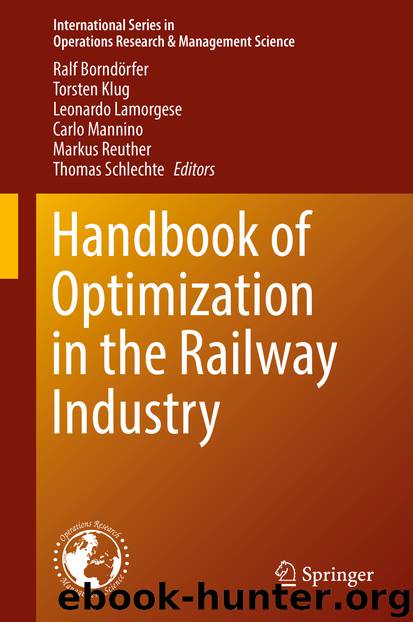Handbook of Optimization in the Railway Industry by Ralf Borndörfer Torsten Klug Leonardo Lamorgese Carlo Mannino Markus Reuther & Thomas Schlechte

Author:Ralf Borndörfer, Torsten Klug, Leonardo Lamorgese, Carlo Mannino, Markus Reuther & Thomas Schlechte
Language: eng
Format: epub
Publisher: Springer International Publishing, Cham
One major disadvantage of time expanded models is their enormous size if the number of time steps increases, e. g., due to a finer discretization. In track allocation the time horizon typically consists of several hours up to several days and the discretization step is often 1 min or less. Hence, the time expanded network of a single train can have many thousands nodes and arcs, which leads to large memory requirements.
In practice there are often conditions that allow reducing the size of these networks. For instance, often a train may not be shifted arbitrarily in time but its schedule may only deviate from an “ideal” schedule by a few minutes. However, this is not always the case and further techniques are required to handle these huge models.
Dynamic Graph Generation, see [11, 13] , is a technique developed for the case where the train schedules may deviate arbitrarily from some ideal timetable, but the general objective is to have all trains run as early as possible. This is a reasonable goal in many applications, because a train running late implies a high delay in the train’s schedule, which should typically be avoided. In particular, the algorithm focuses on the solution of the shortest path subproblems
Download
This site does not store any files on its server. We only index and link to content provided by other sites. Please contact the content providers to delete copyright contents if any and email us, we'll remove relevant links or contents immediately.
Bad Blood by John Carreyrou(6483)
Rich Dad Poor Dad by Robert T. Kiyosaki(6324)
Principles: Life and Work by Ray Dalio(6143)
Playing to Win_ How Strategy Really Works by A.G. Lafley & Roger L. Martin(5787)
Management Strategies for the Cloud Revolution: How Cloud Computing Is Transforming Business and Why You Can't Afford to Be Left Behind by Charles Babcock(4499)
The Confidence Code by Katty Kay(4166)
Thinking in Bets by Annie Duke(4127)
American Kingpin by Nick Bilton(3720)
Delivering Happiness by Tony Hsieh(3338)
Project Animal Farm: An Accidental Journey into the Secret World of Farming and the Truth About Our Food by Sonia Faruqi(3145)
The Power of Habit by Charles Duhigg(3030)
The Tyranny of Metrics by Jerry Z. Muller(2961)
Mastering Bitcoin: Programming the Open Blockchain by Andreas M. Antonopoulos(2957)
Brotopia by Emily Chang(2954)
The Marketing Plan Handbook: Develop Big-Picture Marketing Plans for Pennies on the Dollar by Robert W. Bly(2908)
I Live in the Future & Here's How It Works by Nick Bilton(2907)
The Content Trap by Bharat Anand(2842)
Applied Empathy by Michael Ventura(2816)
Building a StoryBrand by Donald Miller(2812)
